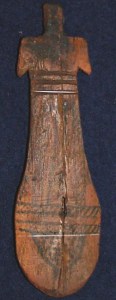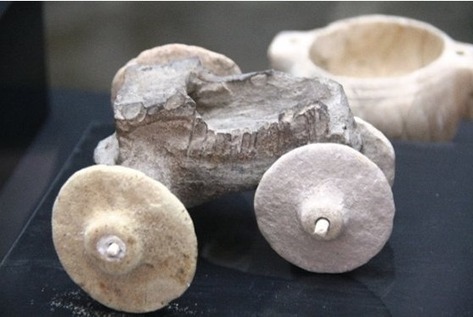Dolls have been around nearly as long as humans have been on this earth. Small human-shaped figurines carved of mammoth ivory dating back to 28,000 and 35,000 years ago were found in Germany. And many believe dolls go back even further in our prehistory too; but, as these even older dolls were likely made of wood and fur, they have long since decayed and therefore no longer exist to be found.
 Since those very early days of doll-kind, other ancient dolls have been discovered made of wood, clay, ivory, marble, stone, bone, leather, cloth, wax, and even papyrus. Not all early dolls were overly simple pieces either. In fact, jointed dolls of clay existed in ancient Egypt, and a fragment of an alabaster doll with movable arms was found in ancient Babylon. That means articulated dolls date back to thousands of years before the birth of Jesus Christ and the start of our current, Gregorian, calendar system!
Since those very early days of doll-kind, other ancient dolls have been discovered made of wood, clay, ivory, marble, stone, bone, leather, cloth, wax, and even papyrus. Not all early dolls were overly simple pieces either. In fact, jointed dolls of clay existed in ancient Egypt, and a fragment of an alabaster doll with movable arms was found in ancient Babylon. That means articulated dolls date back to thousands of years before the birth of Jesus Christ and the start of our current, Gregorian, calendar system!
While we see dolls with movable limbs as having been created to delight children, many archaeologists say that such jointed dolls were charms, created simply to make noise — noise designed to keep bad things away. Truth be told, there is a lot of debate among professionals as to whether these early prehistoric and ancient dolls were first and primarily made for religious reasons, or if they were the playthings of children.
In ancient Egypt, for example, there are many dolls found. Dolls were so popular, that there’s archaeological evidence of an ancient Egyptian doll factory!
 Among the oldest, dating to 3000–2000 BC, are the flat wooden dolls with strands of hair made of sun-baked clay strung on flax thread. These ancient Egyptian dolls seem to emphasize the female form, especially the hips. The wide hips of these dolls have earned them the name “paddle dolls”. The more exaggerated female shape of these “paddle dolls” leads the experts to believe they are fertility dolls, much like the Venus of Willendorf, and not toys.
Among the oldest, dating to 3000–2000 BC, are the flat wooden dolls with strands of hair made of sun-baked clay strung on flax thread. These ancient Egyptian dolls seem to emphasize the female form, especially the hips. The wide hips of these dolls have earned them the name “paddle dolls”. The more exaggerated female shape of these “paddle dolls” leads the experts to believe they are fertility dolls, much like the Venus of Willendorf, and not toys.
While we can thank the Egyptians and their elaborate burial rituals for preserving so many of these ancient dolls, the very fact that dolls were included in burial chambers and tombs has lead many to believe that dolls had more to do with religious ideas of death and afterlife than with the life of a child. However, since a number of dolls have survived simply due to the arid environment deftly preserving them, we have other evidence of dolls in Egypt.
When it comes ancient Egyptian dolls, clay dolls seem to have been the most common. For living along the Nile meant everyone had access to the two basic ingredients in sun-baked clay dolls: clay and the sun. Therefore, as strange as it may seem to us, wooden dolls and rag dolls made of cloth (often stuffed with papyrus as well as textile scraps) were more costly than clay and not so available for everyone. But while those dolls may have been more expensive (and, by today’s thinking, more coveted), clay dolls seem to have been very popular among children. No matter what level of society they lived in. That’s probably because the children themselves could make and “bake” their very own clay doll designs. Not unlike what many children do today with modeling clay.
When and how dolls truly became the playthings of childhood is very open to debate. In some cultures, old and new, dolls are made for use in religious ceremonies; however, once the ceremony is over, the ceremonial dolls are “retired” and given to children as playthings.
In ancient Greece and Rome, the lines between dolls for religious ritual and childhood pastime appear to have a very different trek — and an exceptionally poignant connection.
 Dating back to at least 200 BC, many dolls in Greece and Rome had jointed limbs that moved, and some even had removeable clothing too. Then, as now, doll clothing was as fashionable and up-to-date as what young ladies and women of the day were wearing. (It’s difficult to imagine that such clothing would be purely for religious reasons.) We know this from the number of young girls buried with dolls. Most dolls found in the tombs of children were very simple creations made of terracotta, rags, wood, or bone. However, some of the more unique dolls, designed to look as lifelike as possible, were made of ivory or wax.
Dating back to at least 200 BC, many dolls in Greece and Rome had jointed limbs that moved, and some even had removeable clothing too. Then, as now, doll clothing was as fashionable and up-to-date as what young ladies and women of the day were wearing. (It’s difficult to imagine that such clothing would be purely for religious reasons.) We know this from the number of young girls buried with dolls. Most dolls found in the tombs of children were very simple creations made of terracotta, rags, wood, or bone. However, some of the more unique dolls, designed to look as lifelike as possible, were made of ivory or wax.
There also are the stories and images from ancient Greece which depict little girls playing with dolls. And, in fact, the ancient Greek word “kore”, which literally means “little girl”, was also applied to dolls. This takes on an even more powerful meaning when a young Greco-Roman girl came of age.
As a Greco-Roman girl approached marital age, she would dedicate her doll to a goddess. This doll dedication was a gift presentation given to the goddess in hopes of receiving the blessing of fertility during marriage. When she became a woman, she would literally put away her childish things!
While the archaeological record may seem confusing in terms of the true origins and purpose of dolls in human history, it is not difficult to imagine that children would be fascinated by miniature versions of people. No matter what the original purpose of dolls, children would want to play with them.
Image Credits (in order of appearance): Egyptian rag doll, paddle doll, and ancient Grecian bone doll with articulated limbs.






